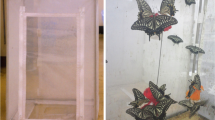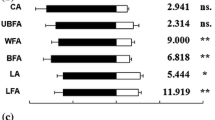Abstract
Chemical communication was shown to play a role in the pear psylla, Cacopsylla bidens. Electrophysiological (EAG) and behavioral responses were investigated in males and females pear psylla . Males were found to be attracted to females, and especially to those on host plants, but not to males, uninfested host plants, or plants infested with conspecific larvae. On the other hand, females were not attracted to males or females but displayed some attraction to host plants. Furthermore, females showed a preference for uninfested pear versus plants infested with conspecific larvae. The antennae of males gave highest electroantenographic response to volatiles from pears infested with females but not males, while females, responded also toward the volatiles of pear alone. These results indicate that females of C. bidens emit sex pheromones that are attractive to the males and suggest that, host volatiles may play a role in host selection by pear psylla females.
Similar content being viewed by others
REFERENCES
Adams, R. G., Domeisen, C. H., and Ford, L. J. (1983). Visual trap for monitoring pear psylla (Homoptera: Psyllidae) adults on pears. Environ. Entomol. 12: 1327–1331.
Adams, R. G., and Los, L. M. (1989). Use of sticky traps and limb jarring to aid in pest man-agement decisions for summer populations of the pear psylla (Homoptera: Psyllidae) in Conneticut. J. Econ. Entomol. 82: 1448–1454.
Bernays, E. A., and Chapman, R. F. (1994). Host-Plant Selection by Phytophagous Insects, Chapman and Hall, New York.
Burckhardt, D., and Hodkinson, I. D. (1986). A revision of the west Palearctic pear psyllids (Hemiptera: Psyllidae). Bull. Entomol. Res. 76: 119–132.
Campbell, C. A. M., Dawson, G. W., Griffiths, D. C., Pettersson, J., Pickett, J. A., Wadhams, L. J., and Woodcock, C. M. (1990). Sex attractant pheromone of damsonhop aphid Phorodon humuli (Homoptera, Aphididae). J. Chem. Ecol. 16: 3455–3463.
Clark, L. R. (1963). Factors affecting the attractiveness of foliage for oviposition by Cardiaspina albitextura (Psyllidae). Aust. J. Zool. 11: 20–34.
Dicke, M. (2000). Chemical ecology of host-plant selection by herbivorous arthropods: A multitrophic perspective. Biochem. Syst. Ecol. 28: 601–617.
Dicke, M., and van Loon, J. J. A. (2000). Multitrophic effects of herbivore-induced plant volatiles in an evolutionary context. Entomol. Exp. Appl. 97: 237–249.
Drukker, B., Bruin, J., and Sabelis, M. W. (2000). Anthocorid predators learn to associate herbivore-induced plant volatiles with presence or absence of prey. Physiol. Entomol. 25: 260–265.
Dunkelblum, E. (1999). Scale insects. In Hardie J., and Minks, A. K. (eds.), Pheromones of Non-Lepidopteran Insects Associated with Agricultural Plants, CABI Publishing, Wallington, UK, pp. 251–277.
Hardie, J., Pickett, J. A., Pow, E. M., and Smiley, D. W. M. (1999). Aphids. In Hardie, J., and Minks, A.K.(eds),Pheromones of Non-Lepidopteran Insects Associated with Agricultural Plants, CABI Publishing, Wallington, UK, pp. 227–251.
Hardie, J., Visser, J. H., and Piron, P. G. M. (1994). Perception of volatiles associated with sex and food by different adult forms of the black bean aphid, Aphis fabae. Physiol. Entomol. 19: 278–284.
Horton, D. R. (1994). Relationship among sampling methods in density estimates of pear psylla (Homoptera: Psyllidae): Implications of sex, reproductive maturity, and sampling location. Ann. Entomol. Soc. Am. 87: 583–591.
Horton, D. R. (1999). Monitoring of pear psylla for pest management decisions and research. Integ. Pest Mgmt. Rev. 4: 1–20.
Horton, D. R., and Krysan, J. L. (1991). Host acceptance behavior of pear psylla (Homoptera: Psyllidae) affected by plant species, host deprivation, habituation, and egg load. Ann. Entomol. Soc. Am. 84: 612–627.
Karban, R., and Baldwin, I. T. (1997). Induced Responses to Herbivory, University of Chicago Press, Chicago.
Krysan, J. L. (1990). Laboratory study of mating behavior as related to diapause in overwintering Cacopsylla pyricola (Homoptera: psyllidae). Environ. Entomol. 19: 551–557.
Lapis, E. B., and Borden, J. H. (1993). Olfactory discrimination by Heteropsylla cubana (Homoptera: Psyllidae) between susceptible and resistant species of Leucaena (Leguminosae). J. Chem. Ecol. 19: 83–90.
Mensah, R. K., and Madden, J. L. (1992). Factors affecting Ctenarytaina thysamura oviposition on Boronia megastigma terminal shoots. Entomol. Exp. Appl. 62: 261–268.
Moran, V. C., and Brown, R. P. (1973). The antennae, host plant chemoreception and probing activity of the citrus psylla, Trioza erytreae (Del Guercio) (Homoptera: Psyllidae). J. Entomol. Soc. S. Afr. 36: 191–202.
Nehlin, G., Valterova, I., and Borg-Karlson, A. K. (1994). Use of conifer volatiles to reduce injury caused by carrot psyllid, Trioza apicalis Forster (Homoptera, Psylloidea). J. Chem. Ecol. 20: 771–783.
Ochieng, S. A., Park, K. C., and Baker, T. C. (2002). Host plant volatiles synergize responses of sex pheromone-specific olfactory receptor neurons in male Helicoverpa zea. J. Comp. Physiol A. Neuroethol. Sens. Neural Behav. Physiol. 188: 325–333.
Pettersson, J., Kaunaratne, S., Ahmed, E., and Kumar, V. (1998). The cowpea aphid, Aphis crassivora, host plant odours and pheromones. Entomol. Exp. Appl. 88: 177–184.
Pickett, J. A., Wadhams, L. J., and Woodcock, C. M. (1992). The chemical ecology of Aphids. Annu. Rev. Entomol. 37: 67–90.
Quiroz, A., Pettersson, J., Pickett, J. A., Wadhams, L. J., and Niemeyer, H. M. (1997). Semio-chemicals mediating spacing behavior of bird cherry-oat aphid, Rhopalosiphum padi, feeding on cereals. J. Chem. Ecol. 23: 2599–2607.
Schoonhoven, L. M., Jermy, T., and Van loon, J. A. A. (1998). Insect-Plant Biology. From Physiology to Evolution, Chapman and Hall, London, pp. 383.
Scutareanu, P., Drukker, B., Bruin, J., Posthumus, M. A., and Sabelis, M. W. (1996). Leaf volatiles and polyphenols in pear trees infested by Psylla pyricola. Evidence of simultaneously induced responses. Chemoecology. 7: 34–38.
Scutareanu, P., Drukker, B., Bruin, J., Posthumus, M. A., and Sabelis, M. W. (1997). Volatiles from psylla infested pear trees and their possible involvement in attraction of anthocorid predators. J. Chem. Ecol. 23: 2241–2260.
Scutareanu, P., Ma, Y., Claeys, M., Dommisse, R., and Sabelis, M. W. (1999). Induction of p-coumaroyl trihydroxy triterpene acid in Psylla-infested and mechanically damaged pear trees. J. Chem. Ecol. 25: 2177–2191.
Scutareanu, P., Bruin, J., Posthumus, M. A., and Drukker, B (2003). Constitutive and herbivore induced volatiles in pear, alder and hawthorn trees. Chemoecology 6: 63–74.
Singleton-Smith, J., Chang, J. F., and Philogene, B. J. R. (1978). Morphological differences between nymphal instars and descriptions of the antennal sensory structures of the nymphs and adults of Psylla pyricola Foerster (Homoptera: Psyllidae). Can. J. Zool. 56: 1576–1584.
Ullman, D. E. (1985). The Sensory Systems and Feeding Behavior of the Pear psylla, Psylla pyricola Foerster (Homoptera: Psyllidae), phD thesis, University of California, Davis, California.
Ullman, D. E., and McLean, D. L. (1988). Feeding behavior of the winter-form pear psylla, Psylla pyricola (Homoptera: Psyllidae), on reproductive and transitory host plants. Environ. Entomol. 17: 675–678.
Vet, L. E. M., and Dicke, M. (1992). Ecology of infochemical use by natural enemies in a tritrophic Context. Ann. Rev. Entomol. 37: 141–172.
Way, M. J., and Banks, C. J. (1967). Intra-specific mechanisms in relation to the natural regulation of numbers of Aphis fabae Scop. Ann. Appl. Biol. 59: 189–205.
White, T. C. R. (1970). The nymphal stage of Cardiaspina densitexta (Homoptera: Psyllidae) on leaves of Eucalyptus fasciculosa. Aust. J. Zool. 18: 273–293.
Yang, Z. H., Bengstsoon, M., and Witzgal, P. (2004). Host plant volatiles synergize response to sex pheromone in codling moth, Cydia pomonella. J. Chem. Ecol. 30: 619–629.
Zouiten, N., Ougass, Y., Hilal, A., Ferriere, N., Macheix, J. J., and EI Hadrami, I. (2000). Interaction of olive trees and Psylla: Characterization of phenol compounds from new shoots and flower buds and relation to the degree of cultivar resistance. Agrochimica 44: 1–12.
Author information
Authors and Affiliations
Rights and permissions
About this article
Cite this article
Soroker, V., Talebaev, S., Harari, A.R. et al. The Role of Chemical Cues in Host and Mate Location in the Pear Psylla Cacopsylla bidens (Homoptera: Psyllidae). Journal of Insect Behavior 17, 613–626 (2004). https://doi.org/10.1023/B:JOIR.0000042544.35561.1c
Issue Date:
DOI: https://doi.org/10.1023/B:JOIR.0000042544.35561.1c




